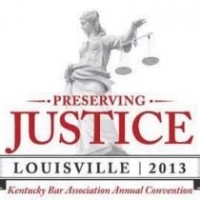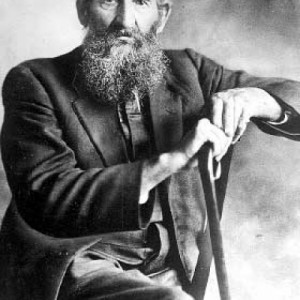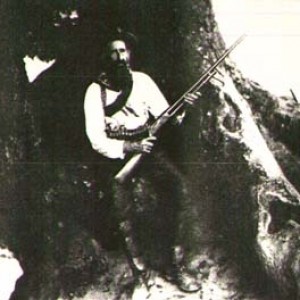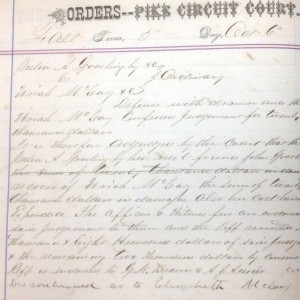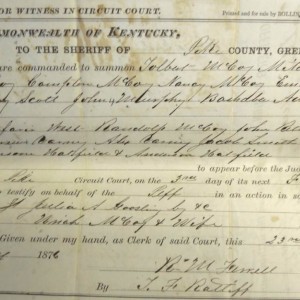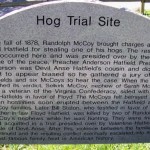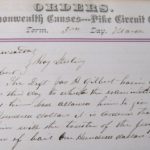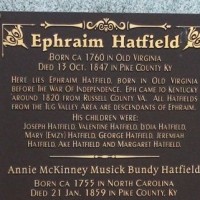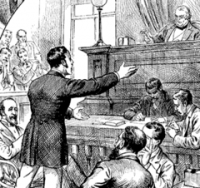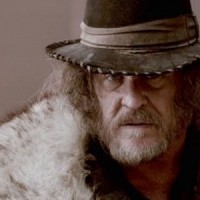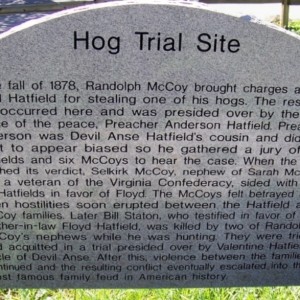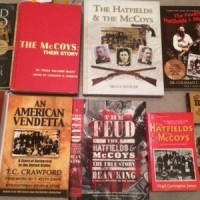This is a continuation of the post of January, 2014. http://hatfield-mccoytruth.com/2014/01/24/kentucky-lawyers-learn-feud-history/
The section entitled “Facts and Fiction,” features the standard disclaimer we see in all the feud yarns, to wit: As there are no actual records, all we can do is sort through the various feud tales and choose the ones we prefer. It says: “The following presentation of events that occurred throughout the Hatfield and McCoy feud is a collection compiled from authors that devoted their research to discovering the most accurate narrative.” Note that they were not told that the presentation would depend upon the actual public records. Like their cited sources, they were looking at prior “narratives,” which means feud books, all but one of which were compilations of unsubstantianted legend and fable. They were picking and choosing from writers who cited as fact sources almost exclusively prior writers who cited nothing.
The presenter writes: “Almost every incident in this feud has several conflicting versions that blame different participants, depending upon whether its source supported the Hatfields or McCoys. But which conveys what really happened? No one can possibly know except the participants themselves, and they are all long dead, the truth buried with them.” The foregoing is a verbatim quote from the group’s favorite source, the novelist, Lisa Alther. So, of all the events that have transpired since mankind discovered the art of writing, the Hatfield and McCoy feud is the only significant part of anyone’s history where the facts are now lost, because “Only the participants knew, and when they died, the truth died with them.” This is pure hokum, as the first two “feud events” in the presentation show.
The story says: “The first incident between the families was the murder of Harmon McCoy, Ranel’s brother. Harmon had been a Union sympathizer and was treated with hostility by Confederate supporters. One particular supporter, Jim Vance, threatened Harmon’s life. Vance was Devil Anse’s uncle and was well known for his ruthless and violent nature. After Vance’s threat Harmon went into hiding for fear of his life. Not long after, he was shot and most attributed his death to Vance.”
Harmon McCoy was more than a “Union sympathizer.” He enlisted first in a company of Union Home Guards, in February, 1862, and was shot through the chest in a skirmish the day after he enlisted. With his chest wound still open and oozing, he was captured in October while operating with the Home Guards.
In April, 1863, he was discharged from the Union Army hospital in Annapolis Maryland, with his wound still oozing pus. HIs wound healed, he traveled a hundred miles and enlisted in the 45th Battalion, Kentucky Infantry in October, 1863. In May, 1864 he suffered a fracture of both his tibia and fibula, which caused him to miss muster until August. He was then back with his regiment until he was discharged on Christmas Eve, 1864. All of this is actually in the military records, which I have in my possession.
According to the sworn testimony of his widow, Harmon re-enlisted immediately, and was sent home on a holiday furlough. Martha McCoy swore that he was “Killed by Rebels while on his way back to the regiment.” Martha McCoy’s sworn affidavit was witnessed by Basil Hatfield, who served as both Sheriff and County Judge of Pike County. There are more written records about the military career of Harmon McCoy than about any other feud character. I have the records to prove everything I have written, right down to the oozing wound.
Except for the fact that he was Devil Anse’s uncle, the statements about Jim Vance are demonstrably totally false. Jim Vance was elected Constable and appointed justice of the peace in Logan County. He was appointed a deputy sheriff in Pike County, and signed the sheriff’s bond for Harmons brother-in-law, Perry Cline. Vance was never even accused of a single crime in his long lifetime.
In addition to his close association with Harmon’s brother-in-law, Perry Cline, Vance also had dealings with Harmons daughter, Mary McCoy Daniels. I have one record showing that Mary took a note from Jim Vance for a third of the purchase price on a large tract of land in 1875. In that same year, Jacob, the eldest son of Harmon McCoy married Jim Vance’s daughter, Elizabeth. The two families celebrated the nuptials in the home of the bride’s father, Jim Vance.
No one accused Jim Vance of murdering Harmon McCoy until after Vance was murdered. All of this is proved—by the record– in my “Crazy Jim” book.
Knowing that the audience was a roomful of lawyers, the next paragraph truly shocked me. It says: “Ranel eventually retaliated against the Hatfields for the death of his brother when he sued Devil Anse in April 1866 for stealing a horse from his farm in 1864. Randall and Devil Anse filed several similar suits.”
All of the lawsuits in Pike Circuit Court are in the record, and could have been found by the lawyers in attendance. There never was a lawsuit filed by either Ran’l McCoy or Devil Anse Hatfield against the other. In fact, Ran’l never sued a single Hatfield, and Anse never sued a single McCoy.
It takes a mountain of audacity to spin such a yarn to a roomful of lawyers, who can easily do the research to prove it false in detail.
But the lawyers have already been told that there is nothing but the various tales to depend upon for facts, so they just accept the assurance given in the beginning that they are hearing “current and accurate information about the subject matter.” The source given for all the imaginary lawsuits was, again, the novelist, Lisa Alther.
To be continued……..
